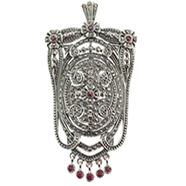By Cynthia Unninayar
In the annals of design, few styles possess the enduring allure and timeless elegance of Art Deco. Originating in the 1920s and flourishing through the 1930s, this iconic movement left an indelible mark on the world of fashion, art, architecture, automobiles, home décor and, of course, jewellery. Designs were largely influenced by Cubism, Futurism, the Bauhaus School, Egyptian, Indian and Asian art, among others. The name was derived from the Exposition Internationale des Arts Décoratifs et Industriels Modernes, held in Paris in 1925, where the style was first exhibited.
Art Deco emerged during a period of profound social and cultural change. Following the turbulent years of World War I, society experienced a renewed sense of optimism and vitality, leading to a desire for innovation and modernity in all aspects of life. Women were also gaining a sense of freedom and independence. During the war, they worked alongside men and, for the first time ever, many became the principal breadwinners while their husbands were fighting at the Front.
“It was soon apparent that the values and attitudes of life before the war—when helpless and fluttering ladies were adorned from head to toe in formal jewels to reinforce the concept of feminine perfection—were truly over,” explains Ioannis Alexandris, antique jewellery expert and chief executive officer of the Gemolithos Group. “A more mature and businesslike woman was now emerging, and she favoured simple, straight-lined clothes and jewellery. On the other hand, she also smoked and drank alcohol, learned to drive a car, played tennis and spent her evenings in nightclubs. It was the era of the flapper, jazz and machines.”

Alexandris adds that the minimal, linear expression “in fashion was adopted by trendy couturiers such as Paul Poiret, Elsa Schiaparelli, Jeanne Paquin and Coco Chanel, who created smart and comfortable suits for the androgynous, yet sexy woman of the 1920s. Jewels became an accessory to match the shape and colour of the dress, rather than a valuable ornament to display the wearer’s wealth, as had been the case in the pre-war years.”
Starting in the 1920s, jewellery designs were two-dimensional and geometric, with strong lines and bold colour palettes crafted in platinum, gold or silver. Bandeaus, clips and linear earrings were characteristic designs, while long sautoir necklaces, often in pearls, sported a tassel. Jewellery reflected the dynamism and exuberance of the Roaring Twenties while also embodying luxury and sophistication.
After the 1929 market crash and ensuing global depression, jewellery production should have dropped, but the opposite occurred. “Jewellery became even bigger and bolder, characterised by massive constructions of ribbons, straps, plaques and buckles,” describes Alexandris. “By the mid-1930s, jewellery was chunkier, three-dimensional and adorned with bows and curves.” The simple geometric links of 1920s bracelets became wider and were worn in large numbers often set with big diamonds or coloured gemstones, sometimes of very high quality. Clips were worn in pairs and the pendant earrings were replaced by large clips of scrolls, flowers or leaf patterns.
“Symmetrical patterns, such as chevrons, sunbursts, and zigzags were popular and created a sense of harmony and balance. One of the most iconic features of Art Deco jewellery is the use of vibrant gemstones and contrasting materials. The jewellers of the Art Deco epoch produced some of the most dazzling pieces ever created,” smiles Alexandris.
Art Deco jewellers were also pioneers in the use of innovative techniques and materials. The advent of mechanised production methods allowed for greater precision and efficiency, enabling artisans to create intricate pieces with remarkable consistency. This technological advancement, coupled with a keen eye for design, led to the production of jewellery that was both visually stunning and technically impressive.
One notable technique popularised during this era was the use of calibre-cut gemstones. These specially cut stones were arranged in precise patterns, often forming intricate mosaics or geometric designs. The result was jewellery that resembled miniature works of art, with each stone contributing to the overall composition in a harmonious manner. Probably the most famous innovation of this era was the Serti Mystérieux (Mystery Setting) by Van Cleef & Arpels, patented in France in 1933. It is still widely used today. Also, during this era, was the Tutti-Fruitti style, popularised by Cartier and used by other designers.
Despite its relatively brief heyday nearly a century ago, the influence of Art Deco design endures to this day. Its timeless aesthetic continues to captivate designers, collectors and enthusiasts alike, serving as a source of inspiration for contemporary creations. Whether adorning the red carpet or gracing the pages of high-fashion magazines, the enduring art of Art Deco jewellery remains synonymous with luxury, sophistication and style.
